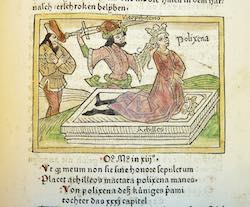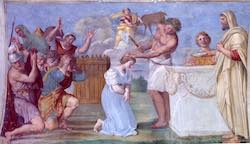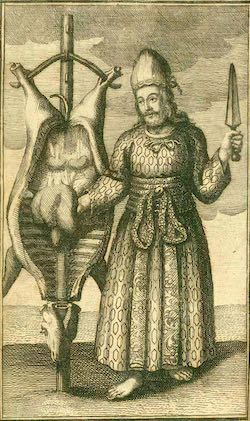Topic: 2. Sacrifice and religion: Comparisons, Antiquarians, Anthropology (16th-18th Century)
Religious sacrifices across various cultures and contexts sparked widespread interest in Early Modern Europe. As Christianity expanded into regions inhabited by "infidels" and "pagans", Europeans encountered a diverse array of sacrificial customs, ranging from the Sati rituals in India to the Aztec sacrifices in the Americas. This cross-cultural exposure captivated a wide audience, including theologians, philosophers, political thinkers, antiquarians, orientalists, missionaries, poets, artists, and even the general public. These encounters broadened the European understanding of sacrifice and led to a critical reassessment of classical and biblical sacrificial rites. This section includes:
- Sources: A selection of early modern printed materials, which include descriptions of the Americas, Asia, and Africa, alongside antiquarian and philological studies on religious sacrifice in classical antiquity and beyond. It also presents early modern works of ethnological observations and the first attempts to compare different sacrificial practices in various traditions and contexts, laying the groundwork for disciplines like the history of religions and anthropology.
- Iconographic Representations: A rich collection of images from the 16th to 18th centuries, illustrating a range of sacrificial rituals and practices as seen in different cultural and geographical contexts.
- Related Bibliography: An extensive bibliography spanning scholarly works from the 19th to 21st centuries, providing contemporary analyses and interpretations of these early studies and observations.
Divisione della carne a Nuzi
in: Sacrificio e società nel mondo antico, pp. 87-95
Roma - Bari: Laterza , 1988.
Ausführliche Beschreibung der Marter, eines heiligen und unschuldigen Kinds Andreae, Von Rinn, in Tyrol, und Bistumb Brixen: welches von denen Juden aus angebohrnem Hass gegen Christum, und gesambten seiner Christenheit grausam gequälet und ermordet worden
Ausgburg: Matthias Wolff, 1724.
Saturn and the Jews
in: Journal of the Warburg and Courtauld Institutes, v. 42 (1979), issue : pp.16-27.
I cavalli del sole : il sacrificio del cavallo nel contesto indoeuopeo : nuove evidenze archeologiche e iconografiche dall'areale altoadriatico
in: Uomini e dei : forme di religiosità tra archeologia, antropologia, storia e folklore, pp. 71-129
San Giovanni in Persiceto: Phoenix Company, 2017.
Neoptolemus Sacrificing Polyxena at Achilles's Tomb (1473)
from: Boccaccio, G. De mulieribus claris, translator Heinrich Steinhöwel, Ulm, Johannes Zainer, [1474], n. p.
Penn Library, Wolverhampton
Iphigenia Sacrifice [1609]
Palazzo Giustiniani-Odescalchi, Bassano Romano
The Origin of the Biblical Scapegoat Ritual: The Evidence of Two Eblaite Text
in: Vetus Testamentum, v. 48 (1998), issue 2: pp.254-263.
The Origin of the Biblical Scapegoat Ritual: The Evidence of Two Eblaite Text
in: Vetus Testamentum, v. 48 (1998), issue 2: pp.254-263.
The Motif of the Corrupted Sacrifice in Aeschylus' Oresteia
in: Transactions and Proceedings of the American Philological Association, v. 96 (1965), issue : pp.463-508.
The Motif of the Corrupted Sacrifice in Aeschylus' Oresteia
in: Transactions and Proceedings of the American Philological Association, v. 96 (1965), issue : pp.463-508.
Judaeo-Christian legal culture and the Qurʾān: the case of ritual slaughter and the consumption of animal blood
in: Jewish-Christianity and the origins of Islam: papers presented at the Colloquium held in Washington DC, October 29-31, 2015 (8th ASMEA Conference)
Turnhout: Brepols, 2018.
Des êtres sacrificiels
in: Sous le masque de l’animal, Essais sur le sacrifice en Afrique Noire, pp. 267-317
Paris: PUF, 1987.
Meanings of Animal Sacrifice during Eid-ul-Adha: Relationships with Religious Orientations and Muslim Experiential Religiousness in Pakistan
in: Archive for the Psychology of Religion, v. 37 (2015), issue 1: pp.37-53.
Beschreibung Der Religion Und Heiligen Gebräuche Der Malabarischen Hindous Nach Bemerkungen in Hindostan Gesammelt
Berlin: Königlich Preussische akademische Kunst- und Buchhandlung,, 1791.
Genealogie der malabarishen götter Aus eigenen schriften und briefen der heiden zusammengetragen und verfasst
Madras: Selbstverlag Germann, 1867.
Of Body & Brush : Grand Sacrifice as Text-Performance in Eighteenth-Century China
Chicago: The University of Chicago Press, 1997.
Ritual Sacrifice of a Calf (1712)
from: Theophili Amilii... Erörterung der dunckelsten und schwersten Schrifft-Stellen im N. Testament, Franckfurt, Samuel Heyl, 1712
Wikimedia & google books
Theophili Amilii... Erörterung der dunckelsten und schwersten Schrifft-Stellen im N. Testament
Franckfurt: Samuel Heyl, 1712.



